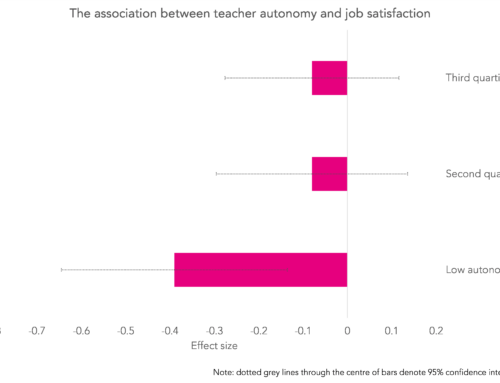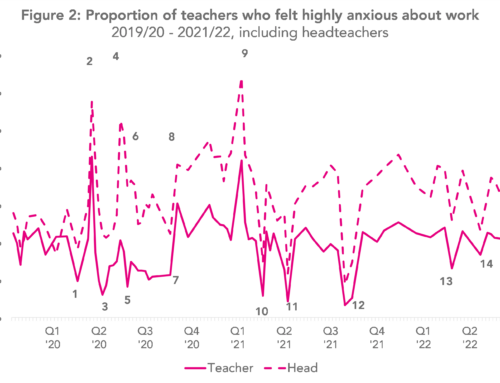Today two new pieces of research on teacher training routes are published. The Institute for Fiscal Studies have published a Nuffield-funded report, authored jointly with Education Datalab and NFER, that summarises the relative costs and benefits of the different teacher training routes. Separately, we have published a report on careers of Teach First Ambassadors who remain in teaching. Taken together, these two reports contribute to a rich perspective on Teach First’s role in training new teachers and creating future leaders.
Teach First is a very expensive way to train teachers
The IFS report estimates the average total cost of training via Teach First to be £38,000, £14,000 higher than any other route. Not all this cost is borne by government – charitable donations to Teach First cover some of the costs, and schools receiving participants pay a charge that contributes to the recruitment and support of the teacher. Nevertheless, given these high costs, it is right that we reflect on the efficiency of its teacher training route.
These costs must be measured in relation to the benefits of the different routes into teaching, of which the most important is the average number of years a new recruit subsequently teaches. Here the retention profile of Teach First looks quite different to other routes. Whilst more Teach First participants achieve QTS and teach the following year, their retention from year 3 onwards looks quite poor. Moreover, once we compare the retention of Teach First to a matched set of PGCE students with similar background characteristics – the same age, gender, ethnicity and subject – the comparison becomes much more challenging. These matched PGCE students have very good retention (shown in blue on the chart below) and so this makes the cost per year of teaching far higher for Teach First.

Note: data quality in the School Workforce Census means we do not know the exact retention rates for any route. Instead we report upper and lower bound estimates of retention. PGCE U is the retention rate for trainees starting full-time HEI-led PGCE courses; PGCE M is the retention rate for a sub-sample of these trainees who are matched to Teach First participants on their age, gender, ethnicity and subject.
If Teach First wasn’t valued by schools, it wouldn’t exist
There are still many critics of Teach First around who hold the view that schools and pupils would somehow benefit if we abolished the programme. This is baffling. Teach First continues to exist and grow because schools want Teach First participants in their schools. They may be expensive, but participating schools choose to take on new participants year-after-year, suggesting the investment is worthwhile. This is corroborated by headteachers’ positive view of the programme (61% saying benefit outweighs costs, compared to 52% for the next best current route, School Direct unsalaried) in a survey.
We don’t have to claim that Teach First participants are outstanding teachers for the programme to be worthwhile. In research I completed with Jay Allnutt in 2013 we showed that school quality improved through participation in Teach First simply because the alternatives for these schools – frequently the use of temporary staff – were so much worse. Teach First wouldn’t be a cost-effective option for a school in a leafy suburb with no recruitment difficulties, but these aren’t the schools they serve.
In a perfect world, Teach First wouldn’t need to exist. Teacher training would be heavily oversubscribed and there wouldn’t be inequalities in access to high quality teachers across schools. But, for now, it serves to mitigate some of the toughest recruitment problems for headteachers serving more disadvantaged communities.
Teach First is a creating the next generation of school leaders serving disadvantaged communities
In this new research we compare Teach First participants to a matched sample of students commencing a full-time HEI-led PGCE course. Although the Teach First participants were more likely to have left teaching after two years, those that stay have amazingly different career trajectories.
They are seven times more likely to be in senior school leadership positions and are taking on more additional responsibilities and middle leadership positions, demonstrated by them earning, on average, £3,000 and £6,000 more by years 3 and 5 in teaching, respectively. They are also much more likely to continue to work in schools in challenging circumstances, including those rated by Ofsted as Requires Improvement or Unsatisfactory.
It is important that new research helps us learn why they have more successful careers
Teach First Ambassadors may be achieving faster rates of promotion as a result of leadership programme they participate in. Or alternatively, it may simply be that Teach First select future stars at the outset. If Teach First are selecting participants who are likely to be successful regardless of training then it is critical that we learn whether those participants would have entered teaching anyway, had Teach First not been available to them.
These questions of selection versus programme effectiveness are important because they help us understand whether the greater costs associated with high quality leadership training are worthwhile. I have written before about what was missing from my own teacher training and career – a working environment surrounded by inquiring minds and a systematic approach to improving practice. Teach First gives their brand new recruits to the profession a tiny exposure to an array of interesting thinkers, researchers and practitioners. Of course brand new teachers cannot develop new ideas around assessment, pedagogy or curriculum in their first year, but it is a window into an world with which they can re-engage when they are ready.
And if this (relatively expensive) exposure really does lead to many Teach First participants achieving more rapid career promotions, then perhaps it tells us something about what all new trainee teachers need.






This is interesting; especially keen on some of the follow up questions. This article was an interesting first complement: https://www.teachfirst.org.uk/blog/how-many-our-teachers-stay-classroom
Are there any stats on teachers who boomerang? From teaching -> other -> teaching again? Probably not significant at this level, although I would guess that the majority of boomerang-ers are TF participants who would not have gone into / stayed in teaching without the programme.
Also note small typo in graph: annd matched … -> and matched …
This is fascinating.
I would like to question your assertion that TF’s that stay have “more successful careers”.
1. They move up to SLT more quickly: but are they effective there. My experience in several schools makes me ask this.
2. Why is moving up to SLT quickly your measure of success. Many teachers do not want to be part of SLT and are very successful in the classroom.
Look forward to your reply.
JJ
Thanks for leaving a comment, Joshua. In answer to your comments:
1. Absolutely – we have no idea whether people who make it to SLT relatively early on in their careers are more or less effective as managers/leaders than those who have more experience. But from the perspective of the teacher you could argue they are “successful”.
2. Sure. Many indeed do not want to reach SLT. We also show they are taking on extra teaching-related responsibilities (i.e. acquiring more TLR points) whilst remaining in the classroom. But again, you may feel this is not a valid measure of success. It is absolutely possible to have a successful career without progressing up the managerial pyramid. Indeed, the shape of the pyramid means that we need many classroom teachers who are happy to remain as classroom teachers for the whole of their career.
Dear Rebecca,
I have just come across this post and found it to be a very interesting read. I am currently looking to undertake research for an EdD in the Birmingham area and am considering a focus around Teach First trainee retention/outcomes. I would be keen to discuss this further with you, given the research that you have undertaken to date?
I hope to hear from you soon.
Kind regards,
L.J.
This is interesting! I’ve read a lot about different routes into teaching. Teach First seems to be good training. I guess it’s handling behaviour the tricky part…